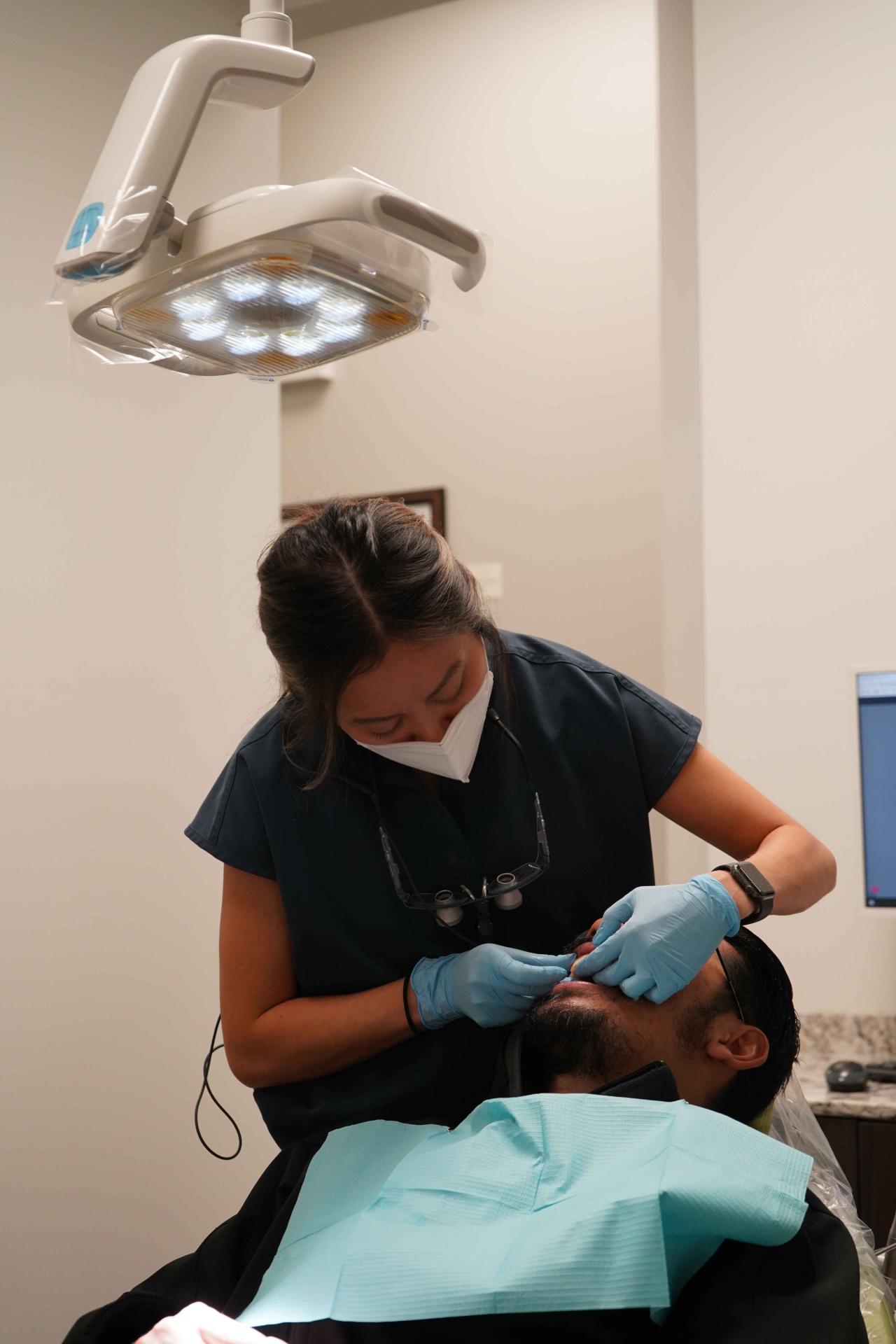At what point is gum grafting necessary?
If your gum is healthy and you have a certain level of recession, gum grafting can be done to reposition the gum so it covers more of the tooth. This can greatly enhance the look of your smile.
What are the best ways to take care of my gums at home after deep cleaning?
For the first one or two weeks after deep cleaning, you might want to use desensitizing toothpaste or gel to reduce potential sensitivity. After that period, it's crucial to floss your teeth after each meal using an interdental brush or a water flosser, and to brush twice a day. Using mouthwash is also recommended. Remember to see your dentist every three to four months for maintenance. It's important to continually educate yourself about and reinforce good oral hygiene habits.
Is dental cleaning painful?
No, dental cleaning is not painful. With modern dental technology and materials, we can numb the gum so you won't feel pain during the procedure. This can be achieved either through numbing gel or local anesthesia, ensuring that you won't feel any discomfort during the procedure.
Why does it take more than one sitting for a dental cleaning?
Deep cleaning can cause a bit of discomfort in your teeth or gums during the first week after treatment. To manage this, we typically clean one side of the mouth (upper and lower teeth, or just upper or lower teeth) at a time, allowing you to chew with the other side. That's why deep cleaning typically requires two visits.
What cause unhealthy gums?
Unhealthy gums are primarily caused by bacteria. These bacteria produce substances that cause inflammation and infection in the gums. Factors facilitating bacterial accumulation include defective fillings or crowns, as well as the presence of plaque or tartar around the teeth and gums. Systemic health conditions such as diabetes, smoking, and hypertension can also weaken the immune system, contributing to gum disease if bacteria are present around the gums.
How can I tell if my gums are healthy or unhealthy?
Healthy gums are pink, firm, and don't easily bleed. If you have gum disease or gingivitis, indicating inflammation and infection around the gums, your gums may appear red and bleed easily. Swelling and pus from the gums could also be signs of unhealthy gums.
Periodontics Dentistry: Periodontal Dentist in Chicago
What is Periodontistry?
A periodontist specializes in preventing, diagnosing, and treating periodontal disease and placing dental implants. Periodontal disease, also known as gum disease, occurs when the gums are infected and can lead to a variety of serious health concerns. Periodontists are expertly trained at diagnosing and treating these symptoms if needed.
What Treatments Do Periodontists Do?
Periodontists are not only experts at helping prevent gum disease before it starts, but they are expertly trained in gum disease treatments. They can help you develop a strong dental care at home to ensure you’re sufficiently taking care of your gums. Should you need treatment for gum disease, they are able to perform various periodontal procedures such as scaling and root planing, flap surgery, pocket reduction surgery, bone grafts, laser therapy, periodontal surgery, and more.
Why is Gum Disease a Health Concern?
If left undiagnosed and untreated, gum disease can worsen and lead to even more complex problems. The bone that supports your teeth can be destroyed and it’s possible for your teeth to loosen and eventually fall out.
Aside from causing issues within your mouth, gum disease is known to be connected to a variety of other diseases including heart disease, diabetes, stroke, and issues with infertility and birth. Your gums help prevent inflammation and damage in your body, and your mouth is a vessel for bacteria and other dangerous particles to enter through. By having severe gum issues, you are then predisposed to an array of other health problems that could otherwise be avoided with good oral hygiene.
The early stage of gum disease is known as gingivitis, which can be reversed with the right oral care routine and frequent checkups if caught early enough. If it isn’t caught or taken care of early enough, then it turns into periodontitis, which is when more serious periodontist intervention is necessary.
When Should You Go to a Periodontist?
While your dentist may be the one to suggest you see a periodontist and refer you, you may also see one on your own accord if you think you may have signs of advanced gum disease.  Some signs your gums are in trouble include puffy or swollen gums, bright red gums, gums that bleed easily or bleed from brushing or flossing, chronic bad breath, loose teeth or puss between teeth, gums that are tender to the touch, gum recession, and painful chewing.
Some signs your gums are in trouble include puffy or swollen gums, bright red gums, gums that bleed easily or bleed from brushing or flossing, chronic bad breath, loose teeth or puss between teeth, gums that are tender to the touch, gum recession, and painful chewing.
If you notice that you are consistently experiencing some or all of these symptoms, you should consider seeing a periodontist or scheduling an appointment with your dentist to see if specialized intervention is necessary.
Periodontists at DentArt
Dr. Nidhi Shah BDS, MS is our highly trained board-certified periodontist and implant surgeon. She has comprehensively mastered the prevention, diagnosis, and treatment of periodontal disease at several private practices and is a member of the American Academy of Periodontology. Her years of experience and comprehensive approach allow her to help clients achieve supreme gum health, even after experiencing advanced gum disease symptoms.
Contact Us Today
Take control of your gum health. With gum disease being easily preventable, it’s important to take the necessary steps to ensure you’re taking the right care of your teeth. For a dentist in West Loop who has a board-certified periodontist ready to work with you to improve your gum health, call us tod

